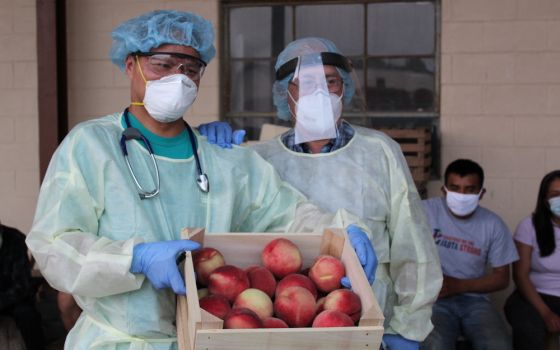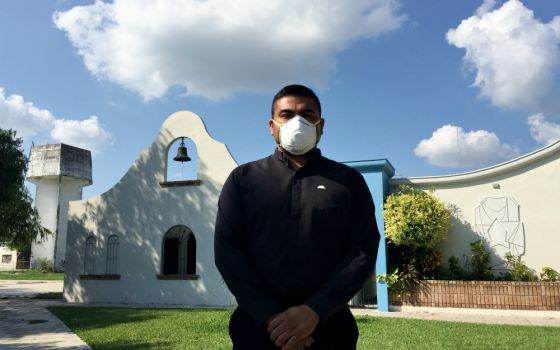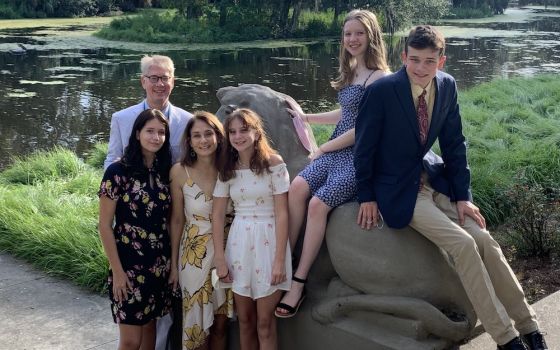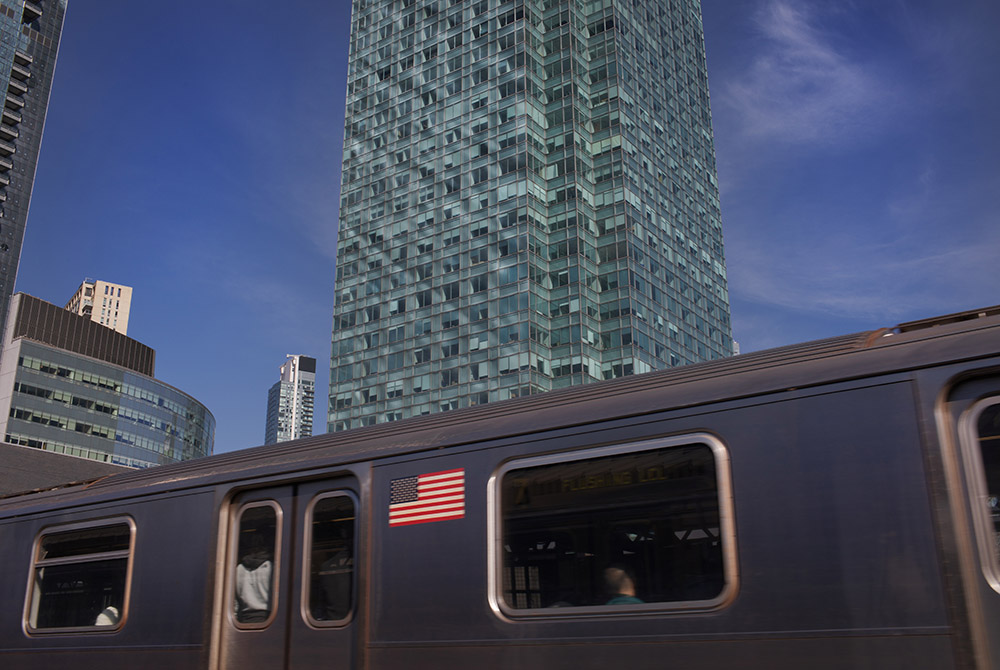
The 7 train travels through Court Square station in Queens, during the coronavirus disease (COVID-19) outbreak, March 14, in New York. (Newscom/Reuters/Nora Savosnick)
Editor's note: On Holy Thursday, Pope Francis prayed for the dead as well as for the priests, doctors and nurses who he said represented the "saints next door" during the coronavirus pandemic. Over the next months, National Catholic Reporter and Global Sisters Report will be bringing the stories of Catholics in this crisis: those who have died, but also those whose service brings hope. To submit names of people for consideration for this series, please send a note to saintsnextdoor@ncronline.org.
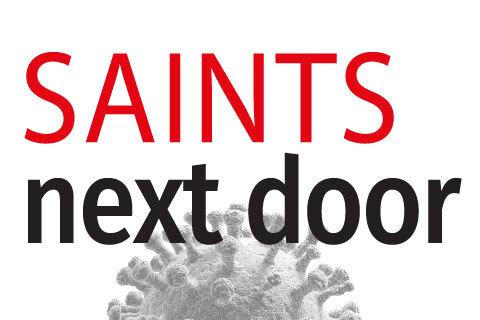
Some New York City subway trains zip, reflecting a metropolis on the move. Others, like the No. 7, rumble, inching methodically along the routes that define them.
The No. 7, almost always packed in normal times, navigates from Manhattan's new gleaming West Side Hudson Yards towers, through Times Square and Grand Central, and then emerges above the immigrant communities of Queens, from the Irish bars in Woodside, to the smell of Indian curry over Roosevelt Avenue, to the sounds of Dominican salsa in Elmhurst and Corona, to the abundance of Asian restaurants in downtown Flushing, where the route ends. In summer, the train is often filled with the giddy sounds of baseball fans on the way to Citi Field or to the U.S. Open Tennis championships.
The tennis stadium is now a makeshift hospital. The streets are eerily quiet. The sounds of ambulances have dominated the street noise in Queens this spring.
There are sorrows amid Corona. No one knows that better than Msgr. Raymond Roden, pastor of Our Lady of Sorrows Church in the Corona neighborhood of Queens, New York.
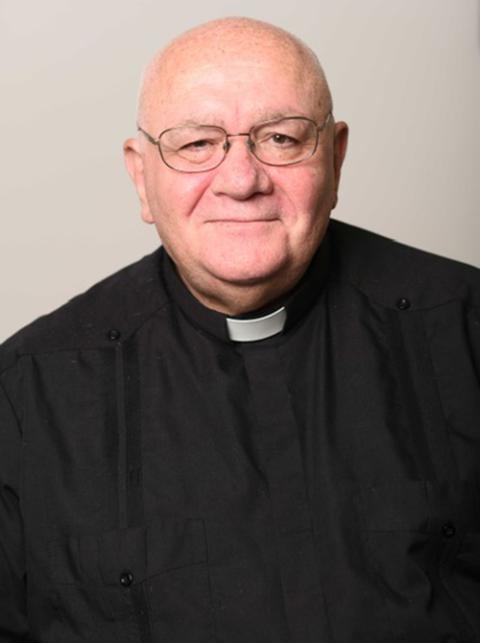
Msgr. Raymond Roden (Courtesy of DeSales Media)
He counts 10,000 parishioners, not easy to do when more than half are undocumented immigrants, not often comfortable in presenting themselves to any authority. It is, he says, the largest of parishes in the Brooklyn Diocese. At Our Lady of Sorrows, he can't count at this point everyone who has died from the coronavirus this spring. That will have to wait for some later date, after real funerals can be permitted.
Right now, he needs to get his own health in order. Every day is a struggle, as he wakes at 11 a.m. after a long sleep, required after returning to his rectory in early April from the hospital after his own bout with the virus.
"I am quite exhausted," says the 68-year-old priest. "I got a kick in the behind from the virus," he adds during an afternoon April 15 phone conversation from the rectory he shares with three other priests. Roden, a former social worker and the son of a New York cop, came to Our Lady of Sorrows for his first pastorate towards the culmination of his priesthood career. He was named a monsignor early this year.
Our Lady of Sorrows is just two blocks from the No. 7 train, the route for immigrant New Yorkers hit hardest by the pandemic. The neighborhoods clustered around the train contain an estimated 600,000 people, and they have so far generated more than 7,000 cases of coronavirus, according to The New York Times. On April 8, The Times reported that more than a third of coronavirus deaths in New York City were Latinos. According to the New York Daily News, the city reported 12,199 total deaths from the coronavirus, as of April 17. Many of those come from the area clustered around the 7 train, with Queens suffering more than any other borough.
Our Lady of Sorrows, notes Roden, is usually a part of that vibrancy. Every weekend there are 12 Masses, nine in Spanish, three in English. Now there are only livestreamed liturgies via YouTube.
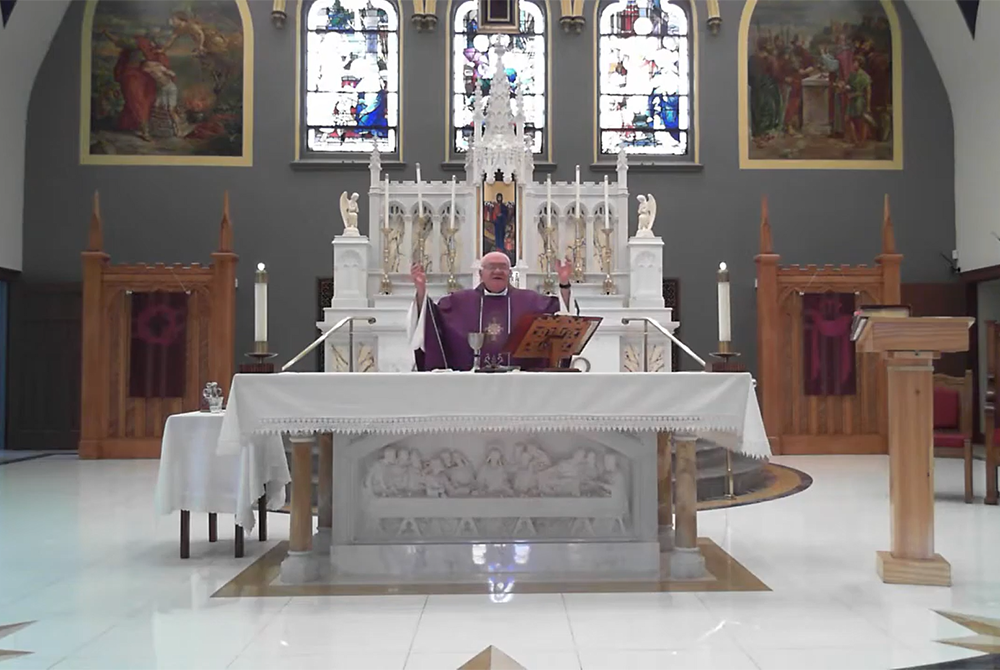
Msgr. Raymond Roden, pastor of Our Lady of Sorrows Church in the Corona neighborhood of Queens, New York, in a screenshot from a livestreamed service March 22 (NCR photo/YouTube)
"We got clobbered, a lot of deaths and illness," says Roden. The deaths include parents in the parish school, as well as the organizer of the parish's annual Our Lady of Guadalupe celebration, which attracts nearly 20,000 every year.
The parish is a mix of Latino New York: Mexicans, Ecuadorans, Dominicans, and Guatemalans, among others. The nearby Flushing Meadows Park, the site of massive World's Fairs in 1939 and 1964, is a neighborhood hangout, filled with soccer matches comprising teams where workers from restaurants enjoy a day off. Now there are too many days off for immigrant restaurant workers in New York.
In retrospect, the warning signs of the impact of a deadly virus in Corona were there. Simple frame houses packed with families created crowded conditions where disease can flourish. "The housing situation is a disaster here," says Roden.
Health care services are overwhelmed. Immigrants in Corona seeking care will often show up at the nearby Elmhurst Hospital, a city facility which earned national notice for the lines of coronavirus patients surrounding it during the early days of the pandemic. In an era of Trump Administration immigration policies, the fear of ICE enforcement sometimes steers patients away. According to the Times, on April 14 New York City noted that over 3,700 deaths in the city were retrospectively attributed to coronavirus, as many never made it to die in a hospital.
Roden wishes he could do more, but his own condition gets in the way. After rising, he gets some breakfast, prays and does some office work. He is used to being out and about in the neighborhood. Not anymore, at least not now.
"I struggle with cabin fever. I am trapped in my room," he says. He tries to read, a difficulty with his lack of energy, and establishing community with the three other priests remains an obstacle, as they maintain healthy social distance.
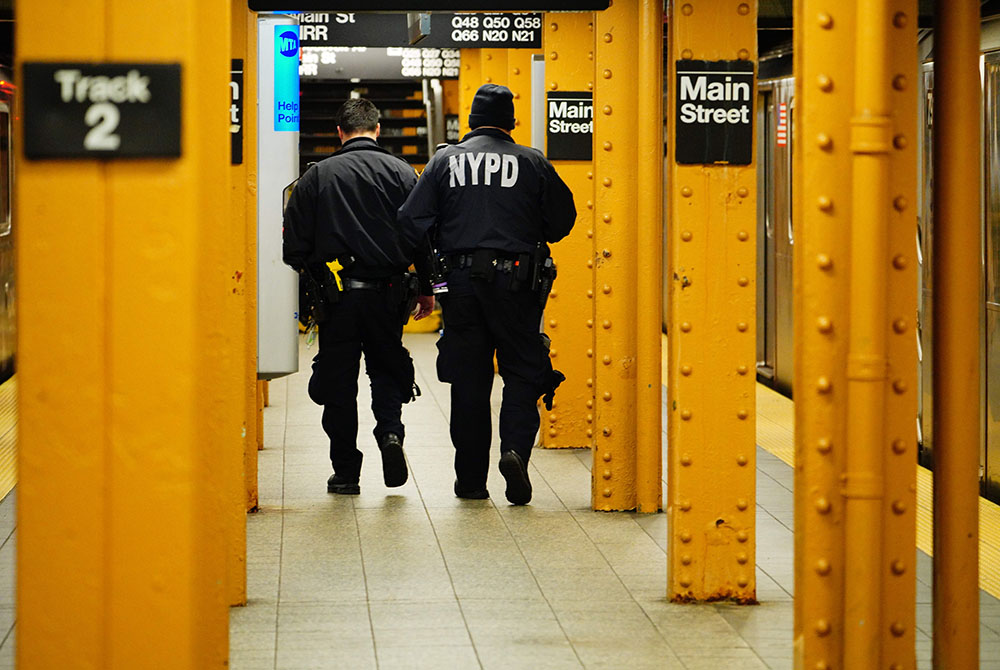
A view of NYPD police officers patrolling the No. 7 train subway April 5 in Flushing, Queens, amid the coronavirus pandemic. (Newscom/NurPhoto via ZUMA Press/John Nacion)
Roden is plagued with thoughts of failure.
"There is a sadness for sure," he says. He takes phone calls from parishioners and can hear the fear and desperation in the Spanish-speaking voices, the terror of the virus, the threat from immigration, and the fear that their restaurant jobs will not return.
The mourners for those who have died are forced to contain their grief. Only two to three people are allowed in cemeteries. Corona is a neighborhood used to crowds, people packing together amid the giant processions that marks the life of the parish and the little plazas where people gather in good weather.
Amid the fatigue, Roden expresses frustration. Our Lady of Sorrows, which before the virus boasted nearly 400 children in its parish school and some 1,700 religious education students, is now bereft, at least for now, of the sounds of young people. The school is offering online classes.
Advertisement
"I am feeling totally helpless," he admits. "The biggest parish in Brooklyn and Queens just collapsed around me." It's hard to not take it personally, he says, but he recognizes those are irrational thoughts, much like the buzz that went through the neighborhood before the pandemic struck. Rumors abounded that the neighborhood along with the popular Mexican beer named for Corona were targeted. Irrational, yes, says the priest, but the pandemic has generated much irrationality.
"You take it personally but it's not about me. I need to get rational about it," he says. In a parish beyond modest in income, he worries about the bills, just like most of his parishioners.
All the well-planned sacraments for the Lent and Easter seasons will have to wait. The parish was forced to cancel six confirmation ceremonies. At the hospital room he shared with a fellow parishioner, who mourned when he was released, the pastor left his roomie a crucifix as a prayer aid.
Roden figures, once this passes, and the dead are properly mourned, the parish can sponsor giant sacramental celebrations at Flushing Meadow Park. Roden looks towards a glimmer of Easter hope, even in hard-pressed Corona.
[Peter Feuerherd is NCR news editor.]





